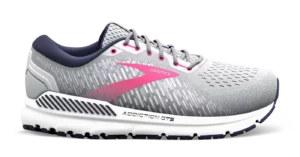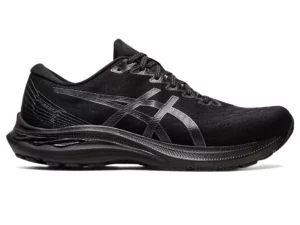In This Article
If you’re searching for the best running shoes for narrow feet, you probably already know how limited and frustrating it can be.
Narrow feet can be a curse when it comes to finding running shoes!
There are 536 men’s road running shoes listed on runningwarehouse.com, but only 6 models have an option for a “B” or narrow width.
In the women’s range of running shoes, the narrow (or “2A” width) limits you to 9 models of 545 options.
It gets worse for trail running shoes for narrow feet in both men’s and women’s ranges – there are none. Literally zero options!
So with that slightly depressing bit of context, let’s get to the good news.
We’ve got Physiotherapist recommendations on the six available models and the best running shoes for narrow feet in a number of common situations.
We also go through the reason why narrow feet are more injury prone and what you can do about it – skip to that section now.
Need expert advice to get the perfect shoe?
We’ve combined the expertise of a Sports Physiotherapist with a running coach to bring you accurate advice, for FREE!
This app, on Android and ios, offers expert advice on the perfect running shoes for you and your niggles.
The app can also diagnose injury and suggest running sessions that won’t flare up any current niggles.

The best running shoes for narrow feet
Here are our candidates for the best running shoes for narrow feet for both men’s and women’s ranges.
At the bottom of the list, we add in the 3 extra options available in the women’s narrow running shoes range.
Road running shoes for narrow feet – men’s and women’s range
Brooks Adrenaline GTS
Stack height: 36mm, heel-toe offset: 12mm, weight: 289g(m), 249g(f)
Our recommendation: lighter and with more bounce than the previous version, they’ll suit runners looking for a comfortable cushy ride.

The Adrenaline was previously listed as a support shoe but underwent a big design in 2021.
This added “Guide Rails” instead of dual density foam (see here for an explanation of different parts and features of shoes.)
This made the shoe lighter but less supportive.
It’s still probably the most popular running shoe for narrow feet.
You’ll find more details including color options and pricing for the women’s range here and the men’s range here.
Brooks Ghost
Stack height: 35mm, heel-toe offset: 12mm, weight: 272g(m), 238g(f)
Our recommendation: Ghost is a great running shoe for those who like firmer cushioning and protection underfoot.

The Ghost is a comfortable shoe that offers gentle cushioning without being too plush.
It doesn’t offer support, so it won’t suit runners with specific needs like bunions or bad knees.
But it does offer a lightweight speedy shoe with great ground feel.
You’ll find more details including color options and pricing for the women’s range here and the men’s range here.
Brooks Addiction GTS
Stack height: 36mm, heel-toe offset: 12mm, weight: 354g(m), 306g(f)
Our recommendation: runners who are happy to sacrifice some ground feel for a firm base and protection.

Brooks Addiction has been around for over a decade and is still a decent option for those looking for support.
With the Adrenaline now reducing the level of support offered, the Addiction is the perfect replacement for anyone looking to maintain a structured, supportive feel. It’s a heavier shoe but suits those who like the firm, protected feel.
You’ll find more details including color options and pricing for the women’s range here and the men’s range here.
New Balance Fresh Foam 880
Stack height: 34mm, heel-toe offset: 10mm, weight: 289g(m), 249g(f)
Our recommendation: brilliant high mileage running shoe for distance runners looking for responsive comfort.

Similar to the Brooks Ghost, the 880 is designed for cushioning with a decent ground feel.
It’s perfect for everything from high mileage to a daily shuffle.
You’ll find more details including color options and pricing for the women’s range here and the men’s range here.
New Balance Fresh Foam 860
Stack height: 35mm, heel-toe offset: 10mm, weight: 297g(m), 258g(f)
Our recommendation: for runners who like a firm base without too much weight.

New Balance’s 860 is the stability-focused sibling to the 880.
Great for daily runs and high mileage if you need added support and structure.
You’ll find more details including color options and pricing for the women’s range here and the men’s range here.
New Balance Fresh Foam 1080
Stack height: 36mm, heel-toe offset: 8mm, weight: 286g(m), 235g(f)
Our recmmendation: For a higher volume runner (eg. Marathon training) looking for a plush, comfortable ride.

The 1080 is the premium cushioned shoe in New Balance’s range – the big brother of the 880.
It’s fully featured with everything you need to super-comfortable miles.
It doesn’t have support so you’d look to the 860 if you needed the added help.
You’ll find more details including color options and pricing for the women’s range here and the men’s range here.
Road running shoes for narrow feet – women’s range only
Side note for the boys: if you’re looking for the best running shoes for narrow feet and the above 6 shoes don’t fit the brief, you can look at the entire female range as viable options.
Women’s standard fit is the same width as the men’s narrow fit so just find your favourite and don’t forget to adjust your size with an male/female size comparison chart (or just use European sizes which are genderless.)
Asics GT-2000
Stack height: 31mm, heel-toe offset: 8mm, weight: 252g(f)

The most popular shoe in the world, the 2000 has earned it’s reputation over almost 30 years of existence.
It offers a beautiful blend of support and cushioning and it renowned for its out-of-the-box comfort.
You’ll find more details including color options and pricing for the women’s range here.
Asics Kayano
Stack height: 35mm, heel-toe offset: 10mm, weight: 260g(f)

Like the NB 1080, the Kayano is the big brother to the Asics 2000.
Offering support and cushioning, it’s Asics premium shoe and flagship for its road running range.
You’ll find more details including color options and pricing for the women’s range here.
Brooks Glycerin
Stack height: 38mm, heel-toe offset: 10mm, weight: 252g(f)

Brooks offers their popular Glycerin in a narrow fit for female runners.
It’s got plush cushioning and great durability.
You’ll find more details including color options and pricing for the women’s range here.
Trail running shoes for narrow feet
For trail running shoes, there are no options for women’s shoes in a narrow fit.
For men, the best trail running shoes for narrow feet are in the women’s trail range with a female “B” standard width.
That opens up 111 options for trail-specific shoes, compared to zero options in the men’s narrow width range.
How do narrow feet cause injury?
This might sound a little odd but narrow feet put you at increased risk of hip injuries!
Here’s why: think of standing on a plank of timber suspended above the ground – the width of that timber represents the width of the foot in this example.
Then imagine you’re surrounded by lava….nothing to do with biomechanics, but it adds a nice bit of drama, right?
If you were standing on a wide plank of timber, you could balance reasonably well.
Because you’re balanced, you could hop on one leg (assuming the plank didn’t move or bounce around).
Now think of standing on a narrow plank, about half the width of your foot.
Balance would be more challenging – and because you’re not stable, you couldn’t hop.
The brain won’t let you push hard through a leg that doesn’t feel stable.
Pushing would just force you to lose balance and the brain is pre-programmed to avoid that.
So having a narrow plank (aka. narrow foot width) makes it more challenging to balance and reduces the power that you can push through the leg.
Why narrow feet cause hip injuries
So how does all that add up to hip injuries?
If you’re struggling to balance due to a narrow contact surface with the ground, the body needs to use other areas of the body to control balance.
The main area that covers for reduced stability through the feet – you guessed it, the hip!
The hip muscles will need to work harder to contribute to stability, which can lead to early fatigue and overload issues.
This can cause gluteal tendinopathies, deep hip rotator overload and hip impingement issues.
Injury prevention for narrow feet
Narrow feet can make you more prone to certain types of injuries but it doesn’t mean that you’re destined to fail.
Narrow feet may be a limitation in some respects, but the right training and running shoes for narrow feet can easily offset that and leave you less injury prone that most runners.
Footwear for narrow feet
Getting the right running shoes for narrow feet isn’t just about comfort.
Shoes that are too wide allow the foot to move around on landing, encouraging excessive pronation and making stability very challenging.
Finding the right running shoes for narrow feet means finding a shoe that ideally comes in a women’s “2A” or men’s “B” width (for context, a standard width in women’s shoes is a “B” and men’s is a “D” width.)
The good news for the men’s shoes is that the narrow “B” width is exactly the same as the women’s standard width (also “B”), so you’ve got the option of buying women’s running shoes.
(Side bar: the reverse is true for the women’s “D” wide fit – they can use men’s “D” standard fit.)
Exercises to improve stability for narrow feet
The simplest and most effective method of offsetting the biomechanics of narrow feet is to add strength training to your program.
A good hip-focused program will improve the effectiveness and fatigue-resistance of the hip and avoid overload and fatigue-related injuries.
(For some great examples of strength programs, we show you a bodyweight program here and discuss how to design your own program here.)
Affiliate disclaimer for The Best Running Shoes for Narrow Feet
**Special note: this article has Physiotherapist-recommended products with affiliate links to trusted vendors, selected for their fast & reliable service and great prices. The article was written prior to sourcing the affiliate links and the links in no way influence our recommendations.


